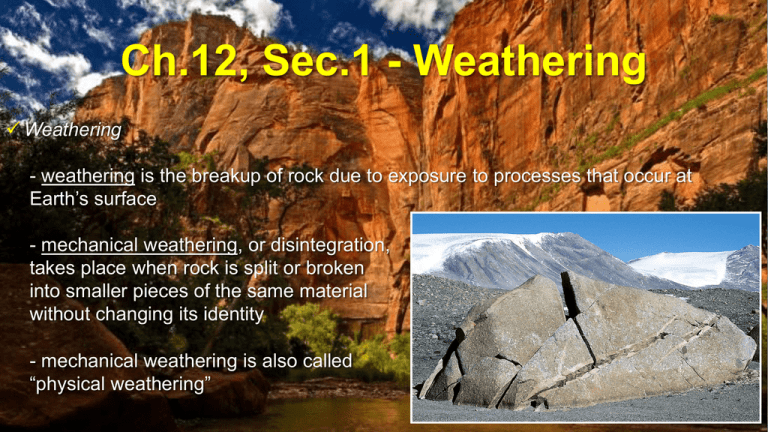Ch.12, Sec.1 - Weathering
advertisement

Ch.12, Sec.1 - Weathering Weathering - weathering is the breakup of rock due to exposure to processes that occur at Earth’s surface - mechanical weathering, or disintegration, takes place when rock is split or broken into smaller pieces of the same material without changing its identity - mechanical weathering is also called “physical weathering” Ch.12, Sec.1 - Weathering - chemical weathering, or decomposition, takes place when rock’s minerals are changed into different substances - mechanical & chemical weathering almost always act together Ch.12, Sec.1 - Weathering Mechanical Weathering - water occupies 10% more space when it freezes, so more pressure is applied to surrounding walls - when water freezes in the cracks of rocks, it wedges the rock apart - frost wedging only occurs in areas where the temperature fluctuates above and below freezing point Ch.12, Sec.1 - Weathering - frost wedging occurs on mountaintops, in porous rocks, and also on our highways (potholes) Ch.12, Sec.1 - Weathering Ch.12, Sec.1 - Weathering Ch.12, Sec.1 - Weathering - mechanical weathering can also create abrasion, which is the grinding of rocks, pebbles, and boulders against one another - sand is a product of abrasion as pebbles get ground down into particles of sand as they are carried by rivers, streams, and ocean waves Ch.12, Sec.1 - Weathering - the growth of plants and the activities of animals also contribute to the mechanical weathering of rock - the roots of trees, shrubs, & mosses help to split rocks as they grow - ants, earthworms, rabbits, woodchucks, and other animals dig holes in soil allowing air & water to weather bedrock Ch.12, Sec.1 - Weathering - the upward expansion of rocks that are formed deep underground may result in a mechanical weathering process called exfoliation - reduced pressure on the surface of granite can create curved joints that are parallel to the surface – eventually they get exposed and break down over time Half Dome (exfoliation dome) at Yosemite National Park, California Yosemite National Park Ch.12, Sec.1 - Weathering Ch.12, Sec.1 - Weathering Stone Mountain (exfoliation dome) in Georgia Stonewall Jackson, Jefferson Davis, & Robert E. Lee (Civil War Heroes for the Confederacy) Ch.12, Sec.1 - Weathering Sugarloaf Mountain (exfoliation dome) in Brazil Sugarloaf Mountain in Rio de Janeiro, Brazil Ch.12, Sec.1 - Weathering Chemical Weathering - chemical weathering occurs almost everywhere because water or water vapor is found almost everywhere - all chemical weathering involves at least one of the following: water, water vapor, oxygen, and acids - the chemical weathering by reaction of water with other substances is called hydrolysis Ch.12, Sec.1 - Weathering - water’s chemical effect on minerals is increased by the presence of acids that are dissolved in the water: carbonic acid & sulfuric acid - carbonic acid is created from excess carbon dioxide (vehicles) & sulfuric acid is created from sulfur burn-off in manufacturing plants - these acids mix with rain in the atmosphere and cause acid rain, which further increases chemical weathering Ch.12, Sec.1 - Weathering - carbonic acid has a dissolving effect on limestone and can create caverns once it mixes with water and seeps into the ground Perry’s Cave at Put-in-Bay, Ohio Mammoth Cave in Kentucky Ch.12, Sec.1 - Weathering - the brown or red color of some exposed rocks may be the result of a process called oxidation - oxidation is a chemical reaction of oxygen with other substances, especially iron-rich rocks Zion National Park, Springdale, Utah Cathedral Rocks, Sedona, Arizona Ch.12, Sec.1 - Weathering Rates of Weathering - under average conditions, weathering is a slow process - the three factors that increase weathering are: surface area, composition of the rock, and climate - more surface area exposed to the elements means faster weathering of the rock more surface area = faster mechanical/chemical weathering Ch.12, Sec.1 - Weathering - granite, quartz, and marble are not easily weathered, whereas gypsum, feldspar, and limestone weather at faster rates - warm, wet climates are conducive to faster mechanical/chemical weathering because of the excessive moisture, changes in pressure, and changes in temperature - cold, dry climates are conducive to faster mechanical weathering because of the excessive winds McMurdo Dry Valley Desert, Antarctica




